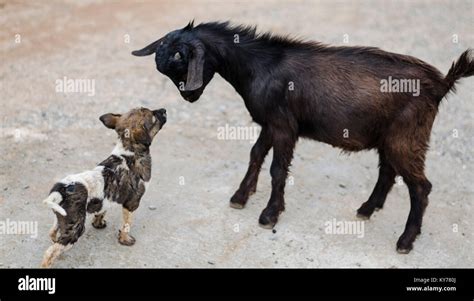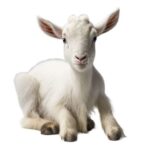
A German Shepherd in Texas has become the unlikely guardian of a group of baby goats, showcasing an unusual interspecies bond that has captured hearts online. Odin, the German Shepherd, has seemingly adopted the kids, providing them with companionship, warmth, and protection.
Odin’s owner, Kyle Nowlin, initially brought the baby goats, referred to as “kids” in agricultural terms, onto his Texas property intending to raise them. He never anticipated that his loyal German Shepherd would form such a strong attachment. According to Nowlin, “Odin has fully embraced his role as a nanny.” The dog spends his days watching over the goats, playing with them, and even letting them sleep on top of him. This endearing behavior has been documented in numerous photos and videos shared on social media, quickly turning Odin and his adopted family into viral sensations.
Nowlin has observed that Odin appears to be protective of the goats, warding off any potential threats and ensuring their safety. This protective instinct aligns with the German Shepherd breed’s inherent traits. German Shepherds are known for their loyalty, intelligence, and herding abilities, making them excellent guard dogs and companions. While their herding instincts are typically directed towards sheep or cattle, Odin has redirected his protective nature toward the baby goats, creating a heartwarming and unconventional family dynamic.
The interspecies relationship between Odin and the goats highlights the capacity for animals to form strong bonds regardless of their species. Animal behaviorists often note that social animals, like dogs and goats, are capable of developing complex relationships based on companionship, mutual care, and protection. Odin’s behavior demonstrates a nurturing instinct that transcends species boundaries.
Nowlin frequently shares updates on Odin and his goat companions on social media platforms, garnering a large following. Many viewers have expressed admiration for the dog’s gentle nature and the heartwarming interspecies connection he shares with the goats. The story serves as a reminder of the unexpected bonds that can form between animals and the capacity for compassion that exists within the animal kingdom.
The bond between the German Shepherd and the baby goats not only tugs at heartstrings but also highlights several aspects of animal behavior, breed characteristics, and the potential for interspecies relationships. Odin’s case is a compelling example of how an animal’s inherent instincts can be adapted and directed in unexpected ways, enriching the lives of both the animals involved and those who witness their connection.
In-Depth Look at Odin’s Behavior and Breed Characteristics
To fully understand Odin’s behavior, it’s essential to consider the inherent traits of German Shepherds. Bred initially for herding sheep, these dogs possess a strong work ethic, high intelligence, and a deep sense of loyalty. Their herding instincts are deeply ingrained, prompting them to protect and guide their flock. In Odin’s case, the absence of sheep or cattle hasn’t diminished his herding instinct; instead, he has redirected it towards the vulnerable baby goats.
German Shepherds are also known for their protective nature, which stems from their history as guard dogs. They are naturally inclined to defend their territory and their human families, often displaying bravery and vigilance. This protective instinct extends to other animals within their social group, as seen in Odin’s dedication to the baby goats’ safety.
According to animal behaviorists, the key to understanding Odin’s behavior lies in his socialization and early experiences. If Odin was exposed to other animals from a young age, he would be more likely to form positive associations with them. While the specific details of Odin’s upbringing are not fully disclosed in the Yahoo! Lifestyle article, it is plausible that he had positive interactions with other animals, fostering his capacity for interspecies bonding.
Moreover, Odin’s affectionate behavior toward the goats indicates a strong sense of empathy. Empathy in animals, though often debated, is generally understood as the ability to recognize and respond to the emotional states of others. Odin’s attentiveness to the goats’ needs, such as providing warmth and companionship, suggests that he is attuned to their well-being and is motivated to alleviate any distress they may experience.
The Science Behind Interspecies Bonding
The relationship between Odin and the baby goats isn’t unique, as numerous examples of interspecies bonding exist throughout the animal kingdom. These relationships often defy conventional wisdom, showcasing that animals are capable of forming strong connections regardless of species boundaries.
Scientists have proposed several theories to explain interspecies bonding. One prevailing theory suggests that these bonds arise from a shared need for companionship and social interaction. Animals, like humans, are social creatures that thrive on connection and mutual support. When deprived of interaction with their own species, they may seek companionship from other animals, leading to the formation of interspecies bonds.
Another theory focuses on the concept of neoteny, which refers to the retention of juvenile traits into adulthood. Animals that exhibit neoteny, such as dogs, are often more playful, curious, and adaptable, making them more receptive to forming bonds with other species. Odin’s playful behavior with the baby goats, coupled with his innate curiosity, may contribute to his willingness to embrace them as his own.
Furthermore, hormones play a crucial role in facilitating interspecies bonding. Oxytocin, often referred to as the “love hormone,” is released during social interactions, fostering feelings of trust, affection, and bonding. It is plausible that Odin’s interactions with the baby goats trigger the release of oxytocin, strengthening his attachment to them.
The Impact of Social Media on Animal Stories
Odin’s story quickly gained traction on social media platforms, captivating viewers worldwide. Social media has become a powerful tool for disseminating animal stories, raising awareness about animal welfare, and fostering a sense of connection between humans and animals.
The widespread popularity of Odin’s story highlights the public’s fascination with animal behavior and interspecies relationships. People are drawn to stories that evoke emotions, challenge conventional norms, and offer a glimpse into the unexpected connections that exist within the animal kingdom.
Social media also plays a role in shaping perceptions of animal breeds. In Odin’s case, his gentle and nurturing behavior challenges stereotypes associated with German Shepherds, which are often perceived as aggressive or intimidating. Odin’s story demonstrates that breed is not the sole determinant of behavior and that individual animals can exhibit a wide range of traits and personalities.
However, social media also has its drawbacks. The spread of misinformation and the potential for exploitation are significant concerns. It is crucial to critically evaluate information shared on social media and to ensure that animal stories are presented ethically and responsibly. Nowlin has largely been praised for his responsible approach to sharing Odin’s story, focusing on the heartwarming bond between the dog and the goats while prioritizing their well-being.
Ethical Considerations and Animal Welfare
While Odin’s story is undeniably heartwarming, it also raises ethical considerations related to animal welfare. It is essential to ensure that the animals involved are healthy, safe, and well-cared for.
In Odin’s case, Nowlin appears to be a responsible caregiver who prioritizes the animals’ needs. He provides them with adequate food, shelter, and veterinary care. He also ensures that Odin and the goats have ample opportunities for socialization and enrichment, fostering their physical and mental well-being.
However, not all interspecies relationships are beneficial for the animals involved. In some cases, one species may dominate or exploit the other, leading to stress, injury, or even death. It is crucial to carefully monitor interspecies interactions and to intervene if necessary to protect the animals’ welfare.
Animal welfare advocates also emphasize the importance of respecting animals’ natural behaviors and needs. While Odin’s story is heartwarming, it is essential to remember that goats and dogs have different needs and social structures. Caregivers should strive to meet these needs and to avoid forcing animals into situations that are unnatural or stressful.
Nowlin’s approach seems to take these considerations to heart, allowing Odin’s interaction with the goats to develop naturally while providing a safe and nurturing environment.
Future Implications and Potential Research
Odin’s story may have implications for future research on animal behavior and interspecies bonding. By studying Odin’s interactions with the baby goats, scientists can gain insights into the mechanisms that underlie interspecies relationships and the factors that promote empathy and compassion in animals.
Further research could also explore the potential benefits of interspecies interactions for animal welfare. For example, introducing a friendly dog into a goat herd could help reduce stress and improve the goats’ overall well-being. Similarly, providing companionship to orphaned or abandoned animals can help them cope with trauma and develop social skills.
The story of Odin and the baby goats also serves as a reminder of the importance of responsible pet ownership and the potential for animals to enrich our lives. By providing animals with love, care, and enrichment, we can foster their well-being and create meaningful connections that transcend species boundaries.
Odin’s unique connection with the baby goats underscores the complex social and emotional capabilities of animals, urging for continued research and ethical considerations in how we understand and interact with them.
Conclusion
The story of Odin, the German Shepherd, and his adopted baby goats is a testament to the remarkable capacity for animals to form strong bonds regardless of species. His heartwarming tale showcases the inherent traits of German Shepherds, the science behind interspecies bonding, and the power of social media to connect people with animal stories. While celebrating these unusual relationships, it’s essential to prioritize animal welfare and ethical considerations to ensure a positive and nurturing environment for all creatures involved. Odin’s story continues to inspire, reminding us of the empathy and compassion that exist within the animal kingdom and the profound connections that can be forged across species lines. His actions offer valuable lessons about animal behavior and the importance of responsible pet ownership, while also prompting deeper reflection on the relationships we form with animals and the ethical responsibilities that accompany these bonds. Odin’s legacy extends beyond social media fame, promoting greater understanding and respect for the intricate lives of animals.
Frequently Asked Questions (FAQs)
-
What breed of dog is Odin, and why is this significant?
- Odin is a German Shepherd. This is significant because German Shepherds are known for their intelligence, loyalty, and herding instincts. While typically directed towards sheep or cattle, Odin has redirected his protective nature toward the baby goats, creating a unique interspecies bond. According to the American Kennel Club, German Shepherds are “Intelligent, loyal, and eager to please,” traits that contribute to Odin’s nurturing behavior.
-
What prompted Odin to adopt the baby goats?
- The exact reasons are speculative, but it’s likely a combination of the German Shepherd’s inherent herding and protective instincts, coupled with his socialization and early experiences. The absence of his typical flock may have prompted him to adopt the vulnerable baby goats, fulfilling his innate desire to care for and protect others. Animal behaviorists suggest that social animals often seek companionship, and Odin may have found this with the goats.
-
How has Odin’s story been received on social media?
- Odin’s story has been widely embraced on social media, captivating viewers with its heartwarming portrayal of interspecies bonding. Many have expressed admiration for Odin’s gentle nature and the unexpected connection he shares with the goats. The story highlights the public’s fascination with animal behavior and the capacity for compassion that exists within the animal kingdom. The viral nature of Odin’s story exemplifies how social media can raise awareness about animal welfare and foster a sense of connection between humans and animals.
-
Are there any ethical considerations when fostering interspecies relationships like Odin’s?
- Yes, ethical considerations are crucial. It is essential to ensure that all animals involved are healthy, safe, and well-cared for. Caregivers must prioritize the animals’ needs, providing them with adequate food, shelter, and veterinary care. Interspecies interactions should be carefully monitored to prevent dominance or exploitation, and caregivers should respect animals’ natural behaviors and needs. Animal welfare advocates emphasize that unnatural or stressful situations should be avoided. Nowlin’s approach seems to consider these aspects, allowing for a natural and safe relationship.
-
Can Odin’s story contribute to future research on animal behavior?
- Absolutely. Odin’s story can provide valuable insights into the mechanisms underlying interspecies relationships, empathy, and compassion in animals. Scientists can study Odin’s interactions with the baby goats to understand the factors that promote these bonds and the potential benefits of interspecies interactions for animal welfare. This research could have implications for improving animal care practices and promoting greater understanding of animal behavior. Future studies could also explore the hormonal and neurological processes involved in interspecies bonding, furthering our understanding of animal cognition and emotion.









